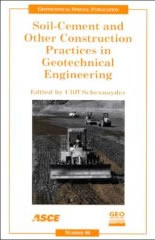
Cast Earth
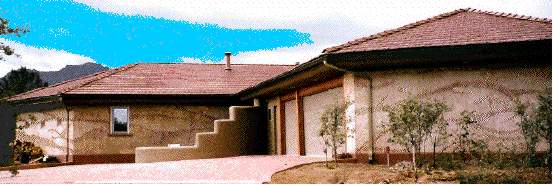
Cast Earth is the invention of Harris Lowenhaupt of Phoenix, Arizona. He grew up in an adobe home in the Southwest and loved the feeling of living in an earthen home. As a chemist he became fascinated with the idea of making earthen homes castable. Instead of making individual adobe blocks for building, or intensively ramming earth into forms little by little, he wanted to be able to just pour the plastic earthen material into a form and have it set up very quickly, within a day!
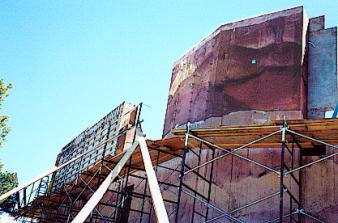 He
started experimenting with adding calcined gypsum (plaster of paris)
to earth, and found that a fairly small percentage (about 15%) of the
gypsum would make a very solid block. This worked fine for very small
projects, but for larger walls it set up way too quickly (within minutes)
to be practical. So he looked for retarding agents that could be added
to the mix to slow down the setup time. Standard retarding agents would
only expand the time frame by a few more minutes, so he needed to look
beyond conventional practice.
He
started experimenting with adding calcined gypsum (plaster of paris)
to earth, and found that a fairly small percentage (about 15%) of the
gypsum would make a very solid block. This worked fine for very small
projects, but for larger walls it set up way too quickly (within minutes)
to be practical. So he looked for retarding agents that could be added
to the mix to slow down the setup time. Standard retarding agents would
only expand the time frame by a few more minutes, so he needed to look
beyond conventional practice. 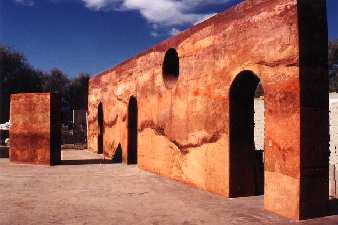
In the early 1990's, Harris came up with a promising mix that allowed about two hours of working time and he build his first prototype building using this method in 1995. Since then he has refined the process to allow setup times of over eight hours, which makes possible very large scale building projects.
Cast Earth has some very interesting and useful properties. The
compressive strength is about the same as adobe or rammed earth, sufficient
to support most conventional building loads. The tensile strength, however,
is several times greater than these materials, which makes it much stronger
and perhaps more durable. Unlike adobe, Cast Earth does not shrink as
it cures (it actually expands slightly), making it much less likely
to crack. Like other earthen materials, it will absorb moisture, but
it retains enough strength, even when saturated, to maintain its structural
integrity. It can be rendered moisture resistant by the use of additives
to the original mix, or by spraying the finished product with a silicon
spray.
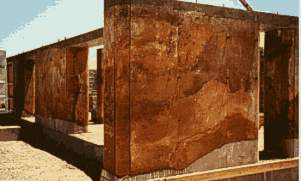 Another
major consideration is that Cast Earth can be made from a wide variety
of types of soil. Unlike Adobe, rammed earth, and cob (which must have
a certain ratio of clay to larger aggregate soil), Cast Earth does not
require the binding capacity of clay. It can utilize soil with some
clay in it, but this is not necessary. And unlike cement, which cannot
tolerate much fine material like clay, Cast Earth can easily incorporate
it into the matrix it creates.
Another
major consideration is that Cast Earth can be made from a wide variety
of types of soil. Unlike Adobe, rammed earth, and cob (which must have
a certain ratio of clay to larger aggregate soil), Cast Earth does not
require the binding capacity of clay. It can utilize soil with some
clay in it, but this is not necessary. And unlike cement, which cannot
tolerate much fine material like clay, Cast Earth can easily incorporate
it into the matrix it creates.
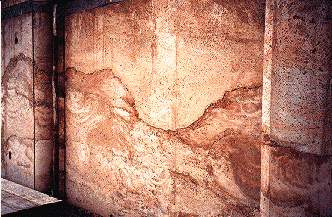 I
think that one of the most significant aspects of this new material
is aesthetic; the completely natural, variegated appearance of the finished
wall that has not otherwise been covered is stunning. It resembles cut
sandstone slabs, with random patterns of striations that swirl throughout
the surface. This fact alone makes it worth considering for your building
project.
I
think that one of the most significant aspects of this new material
is aesthetic; the completely natural, variegated appearance of the finished
wall that has not otherwise been covered is stunning. It resembles cut
sandstone slabs, with random patterns of striations that swirl throughout
the surface. This fact alone makes it worth considering for your building
project.
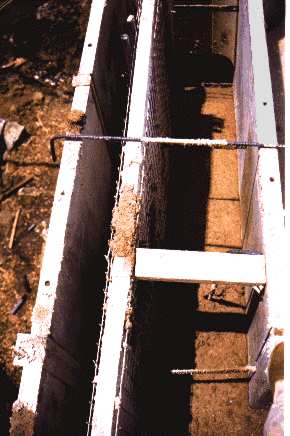 The
thermal properties of cast earth are similar to other earthen materials:
it makes for excellent thermal mass, but has little value as an insulator,
except that because the walls are generally quite thick, and it takes
many hours for atmospheric temperatures to approach the interior portions
of the wall. For this reason it would be best to provide some insulation
in the wall system where extremes of temperature are found. This can
be accomplished with exterior insulation, as would be done with rammed
earth, or it is also possible to imbed the insulation within the wall
at the time of pouring, as shown at the left.
The
thermal properties of cast earth are similar to other earthen materials:
it makes for excellent thermal mass, but has little value as an insulator,
except that because the walls are generally quite thick, and it takes
many hours for atmospheric temperatures to approach the interior portions
of the wall. For this reason it would be best to provide some insulation
in the wall system where extremes of temperature are found. This can
be accomplished with exterior insulation, as would be done with rammed
earth, or it is also possible to imbed the insulation within the wall
at the time of pouring, as shown at the left.
The fact that the process for making Cast Earth has a patent pending
might discourage some folks from getting involved. I can understand
this; I prefer to work with materials and processes that have no strings
attached. However, in this case, Harris is willing to provide training
to those who are are really interested, and the nature of the process
itself demands the use of a lot of heavy, mechanized equipment which
is best handled by people who are familiar with the process. There are
currently several contractors who are licensed to do this work, and
over time there will be more.

All of the photos shown here are courtesy of Cast Earth.
Frankel Salisbury Home this page is very image intensive and takes forever to load, but it shows this architect's home, which uses quite a bit of Cast Earth, under construction.
Soil Cement
A variation of Cast Earth that has been around since cement was first formulated is Soil Cement. This is really just ordinary concrete with the sand/gravel aggregate replaced by soil. This especially works well with rather sandy soil, but will also work with other soil types. The heavier soils with more clay content will probably require more portland cement. Soil cement has been used to form walls, make floors, pave roads, stabilize river banks, etc.
Here is some information about formulas: Make it by mixing earth with Portland cement to the desired depth, add water and mix again. Tamp, and cover with plastic to let it cure properly. Use 6 to 16 percent cement by volume according to the density of the soil. The denser the soil (clay, for instance), the higher percentage of cement to use. Six percent translates to 1 part cement to 15 parts soil; 16 percent translates to 1 part cement to 6 parts soil.
solarsensedesigns.com has a very informative description of making and forming soil cement projects.
Soil Cement Construction Handbook
by Portland Cement Association, 1995

For Email contact go to About Us
Established in 2001, GreenHomeBuilding.com is primarily a labor of love. Kelly, and the GreenHomeBuilding team of experts, have answered thousands of questions for readers over the years, and we continue to publish up-to-date information about increasingly important sustainable architecture. If you feel moved to assist us in this work, your kind donation would be much appreciated; this can be easily done through our PayPal account:

VISIT OUR OTHER WEBSITES:
[Natural Building Blog] [Earthbag Building] [Dream Green Homes]
Disclaimer Of Liability And Warranty
I specifically disclaim any warranty, either expressed or implied, concerning the information on these pages. Neither I nor any of the advisor/consultants associated with this site will have liability for loss, damage, or injury, resulting from the use of any information found on this, or any other page at this site. Kelly Hart, Hartworks LLC.

